In 2014 I joined a newly-founded brand- and packaging design firm in Brussels. The founder had just made a ballsy move. After years of directing two well-established agencies in the country, he decided to start all over, on his own account. I didn’t know squat about the agency or consulting business. But I saw my new boss had an ultra-lucid vision of how to organize and innovate daily work. From the get-go, he had devised his own consultant software toolkit to work with customers, freelance designers, photoengravers, and printing companies.
Bear in mind: This was not a digital consultancy firm, and this was ten years ago. Today, technology-driven consulting is becoming the norm, rather than the exception. So you may wonder: “What consulting tools should I start using today to give my business an innovative edge for the future?” Let’s explore:
What are essential types of consulting software?
Before we delve into the list of innovative tools, let’s first understand what is considered essential consulting software. These solutions are the backbone of your twenty-first-century consultancy. They are designed to assist consultants like you in various aspects of in-house work. But also to work with, and be accessible to your customers.
At Pointerpro, hundreds of our clients are active in consultancy and coaching. From our everyday conversations with them, we can distill the following software types that are relevant to any consultant, regardless of the domain:
- Project management software: Tools that help consultants organize their planning efficiently, enable them to track progress, allocate resources, and meet deadlines. – E.g. Asana
- Communication and collaboration software: Tools that facilitate seamless synchronous and asynchronous communication with customers, team members, and stakeholders. – E.g. Trello
- Finance & HR software: Tools that streamline billing customers, and payment of third-party service providers. – E.g. Workable
- CRM & marketing software: Tools that help consolidate customer information and interactions to track opportunities and tools to set up online campaigns to find potential customers (social media, mailing, etc.). – E.g. Hubspot
We go over some of these in a little more depth and provide some links to example tools in this article about online consulting strategies.
Soon all of your B2B customers will be digital natives. Millennials are the predominant generation of the US workforce, and as of 2024, there will be more Zoomers, than boomers. These customers expect at minimum the digital convenience that comes from the types of tools listed above.
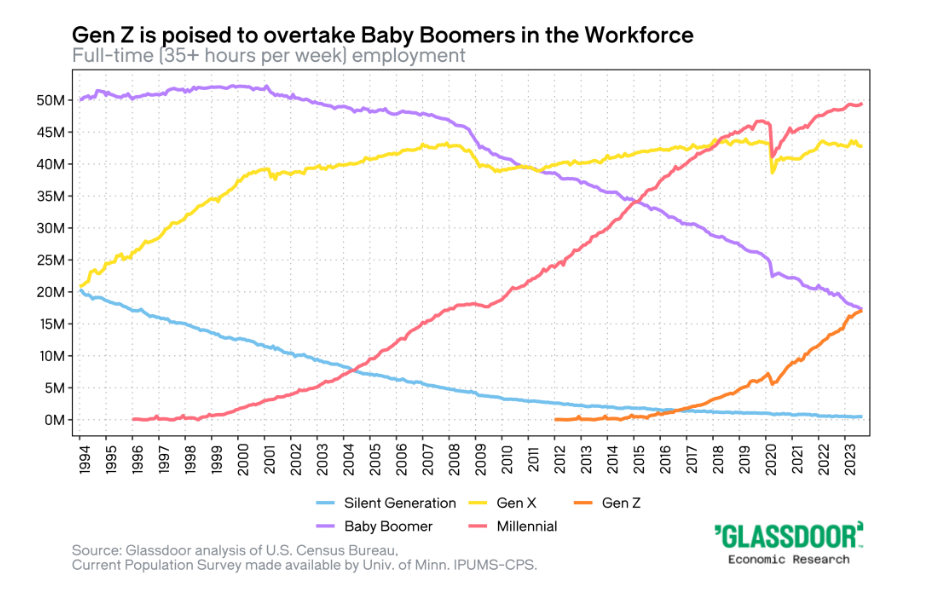
“But what are the benefits for me?”, you might think. As we progress, you’ll notice that the more innovative the consulting tool, the more specific the benefits become. Nonetheless, I’ll first point out a few central questions to ask yourself when adopting a new consulting tool. More precisely, they’re focused on three key benefits.
Key benefits of consulting software to look for
Does it save you time and energy?
In other words, does it make you more productive and efficient? Time is money, quite literally in consulting (at Pointerpro we actually believe it should be different – but that’s another discussion).
To develop your firm, you need to be able to free your time to do strategic or creative work.
Does it improve your output?
Though used interchangeably, even by me, there’s a difference between “digitization” and “digitalization.” Simply put, the first is merely the act of converting analog data into digital data. The second is about improving the result through digitization.
For instance, the exact words you are now reading wouldn’t be better in any real sense if they’d been written on paper (versus them now having been digitized). The fact that I used a digital tool to grammar-check them did make a difference in quality. That’s “digitalization.” A great consulting tool perfects the creative or specialized work the consultant initiates with her or his talent.
Does it increase the expertise of your firm?
Being a consultant implies you are a specialist who stays ahead in your field. That’s why tools that allow for knowledge accumulation and retention are super valuable. Grammar-checking tools improve the quality of output of a copywriting consultant, but they don’t really make her a better writer.
Innovative consulting software: Think outside the box
The main goal of this article is to inspire you to think outside of the box, beyond the discussed essential tools, when it comes to digitalizing your consultancy. What follows now is a list of unconventional consulting software ideas.
Whenever the answer to one of the previous key questions is “yes”, I will attribute a star (⭐) to the tool I’m discussing. That will give you a direct indication of how versatile the benefits of each tool are. Here we go:
1. Mind mapping and virtual whiteboard software: Miro ⭐⭐
The problem(s) it solves:
Companies often hire consultants to bring innovation. That often implies they’re not part of the office workforce. Rather they’ll come in for inspirational sessions and continue their work remotely.
Since 2020, company workers themselves have been more distributed across various locations too. In other words, it becomes more and more challenging for the right people to check in together and brainstorm or collaborate creatively.
How it solves the problem:
Miro addresses the challenges of remote collaboration, brainstorming, and project visualization. It offers a digital, collaborative whiteboard platform that facilitates synchronous and asynchronous teamwork that requires visualization.
Users can create, share, and work together on diagrams, mind maps, and project plans, At Pointerpro we recently used it to brainstorm around our marketing content plan. For instance, we visualized the topics everyone deemed important to be covered on our channels, how specific pieces of content could be repurposed under another format, and also which people would serve as speakers in various online videos.
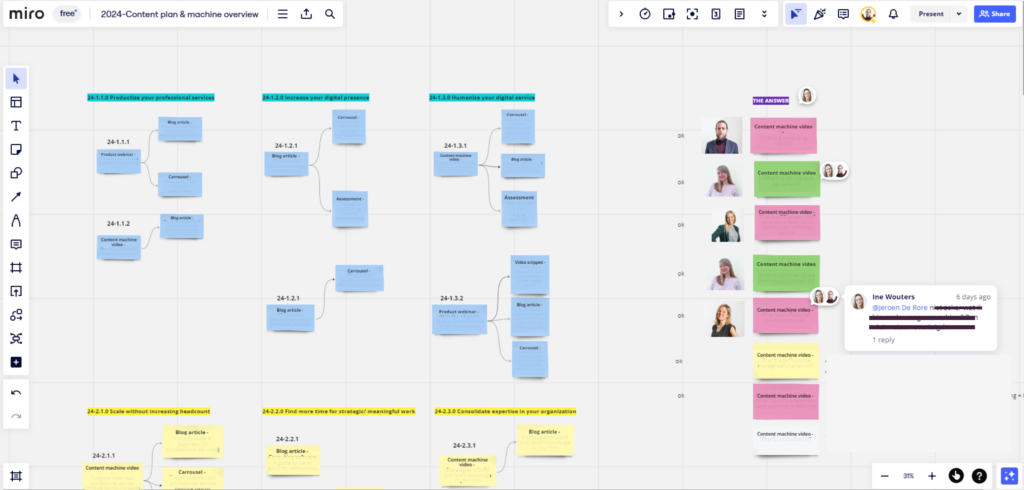
Beyond brainstorming sessions, Miro can also be seen as an alternative to the same-old, linear slide decks for presentation purposes.
How well it offers the key benefits (and why):
- Does it save you time and energy? Yes. Thanks to Miro, there’s no struggle to align people’s calendars and get them in the same meeting room with all the necessary equipment. Ideas and idea structures are easy to modify, comment on, or put aside. Above all, Miro offers many very useful templates to start from.*
- Does it improve your output? The output that is expected from a brainstorming session is generally two-fold: good ideas that people agree on and a structure that helps people involved. Miro delivers on that.
- Does it increase the expertise of your firm? I would say “no.”Miro is mostly designed to represent ideas and structures within the context of a project (for your consultancy’s customer). If you’ve had a successful brainstorm you can re-use the same whiteboard structure the next time around, on another customer’s project. But by design, there are no noteworthy features that allow you to retain the knowledge you’ve absorbed from the project formally.
*Template overview in Miro:
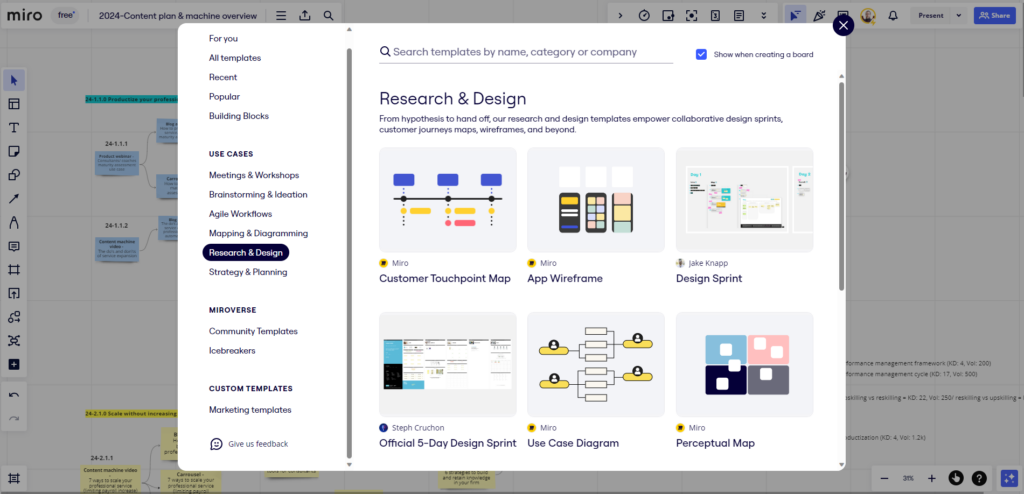
Other mind mapping tools worth checking out:
- MindMeister: A user-friendly tool that’s great for real-time collaboration. It allows for easy sharing and presentation of mind maps, making it ideal for brainstorming sessions with clients or team members.
- XMind: Known for its beautiful design templates and ease of use. XMind is a good choice for consultants who need to create visually appealing mind maps for presentations or reports.
- MindNode: Especially popular among Mac and iOS users, MindNode offers a clean, intuitive interface. It’s great for personal brainstorming and organizing thoughts on the go.
2. Emotion AI: Affectiva ⭐⭐
The problem(s) it solves:
When some people hear or read the word “consultant,” they tend to associate it with analytical – rather emotionless – business. To convince important stakeholders, like upper management in a company you’re consulting for, you’re often required to show dry numbers.
Nonetheless, emotions are extremely important to take into account. In HR consulting, interactions between people often bear more truth and meaning than a detached analysis of a situation.
How it solves the problem:
Affectiva uses advanced AI and emotion recognition technology. Through someone’s webcam, Affectiva analyzes facial expressions and voice patterns to identify emotions and then quantifies them.
This can, for instance, help marketing consultants or agencies understand customer sentiments when evaluating an advertising campaign or help HR consultants measure employee engagement with certain initiatives they’re testing.
On Affectiva’s website, you get to analyze your own engagement with a selection of videos. It’s quite exciting. I watched a James Bond movie trailer. As you can see below, my attention span was stable but dipped a bit near the end (green line) and I had quite a few brow raises (blue-green line). The viewing behavior also gets summarized in numbers and benchmarked, if you click on the “view summary” button.
How well it offers the key benefits (and why):
- Does it save you time and energy? Not really. Emotion analysis gives you unique insights that are different from what an employee survey delivers, for instance. Depending on the project, you can get emotional reactions from a large group of people measured fairly quickly. However, you still have to analyze and interpret the numbers you’re getting – something that a score-based feedback survey does automatically, for instance.
- Does it improve your output? This is definitely what makes Affectiva stand out as a consulting software tool. Instead of second-guessing about how people feel about something you’re pitching, you get to make things concrete.
- Does it increase the expertise of your firm? The more you use it, the more quantified data you’re gathering about people’s emotions. In some sense, that opens up a whole new world of understanding your audiences and stakeholders. So, a “yes” for me.
Other emotion AI tools to check out:
- Realeyes: Uses facial recognition and AI to measure viewers’ emotional responses to video content. It’s helpful for consultants in advertising and media to gauge audience reactions.
- Noldus FaceReader: This tool is often used in academic and consumer research for facial expression analysis. It could be suitable for consultants involved in detailed behavioral studies.
3. Idea management platform: Brightidea ⭐⭐⭐
The problem(s) it solves:
Sparking, gathering, evaluating, and implementing innovative ideas within an organization is very challenging. Nonetheless, it’s often a big part of what organizations expect from consultants. Traditional methods of idea collection can be unstructured and inefficient. The bigger the organization, the bigger this problem gets.
Even if an idea makes its way to a pitch to the board, it’s much too often through a very arbitrary process.
How it solves the problem:
Brightidea allows consultants or organizations to crowdsource ideas from employees, customers, or the public. Its Idea Box app provides an end-to-end solution for the collection, evaluation, and implementation of ideas.
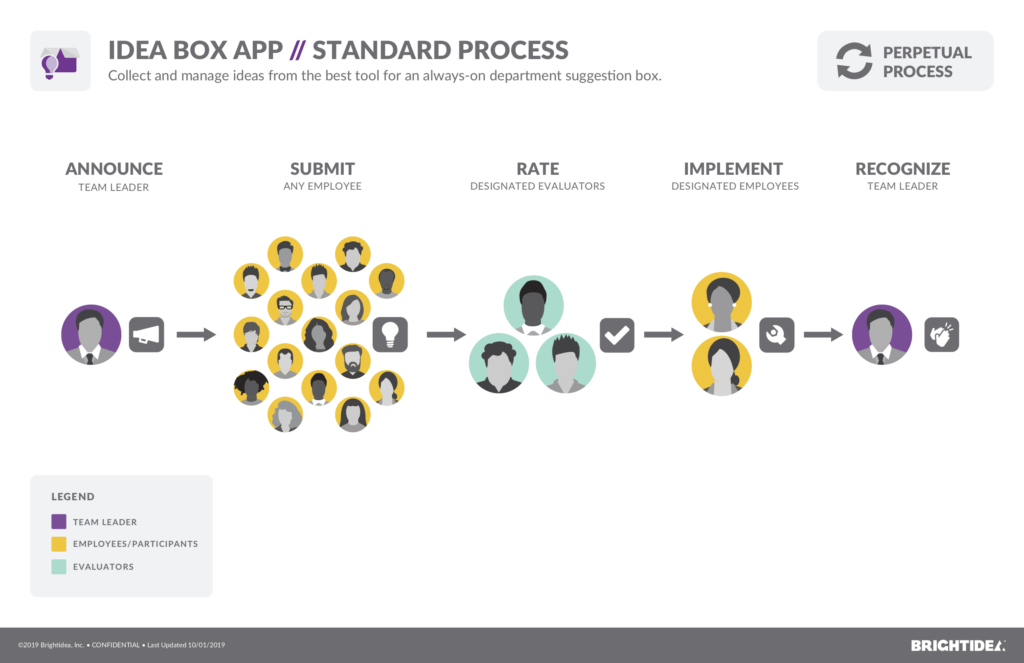
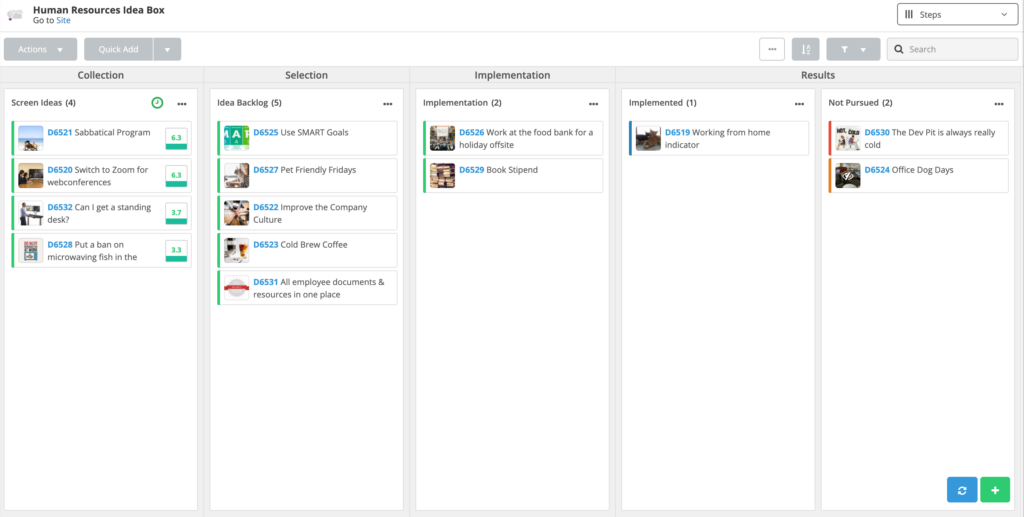
But really, Brightidea is more of a consulting software platform, that offers a variety of apps. Two of the more innovative examples:
- Brightidea Program: To explore market ideas, optimize ideas, slash costs, and actively support the intrapreneurial behavior of employees.
- Brightidea Lab and Brightidea Understand: To take on some riskier ideas that require a bit more rigor. It contains features to monitor trends, research, steer away from bias, experiment and iterate.
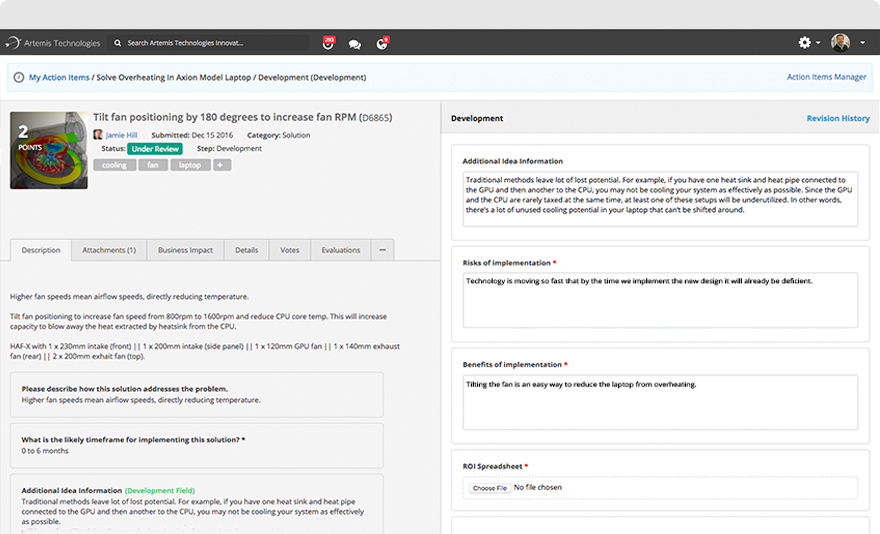
How well it offers the key benefits (and why):
- Does it save you time and energy? For sure. Brightidea is really all about streamlining the innovation process. It reduces the time spent on administrative tasks and focuses on actionable ideas, saving both time and energy.
- Does it improve your output? Another yes. The point of the solution is, after all, to get good ideas developed into actual solutions or go-to-market strategies.
- Does it increase the expertise of your firm? Yes. In some sense Brightidea is a blueprint for how to approach an entire and even complex lifecycle of innovation. It can really help you position your consultancy firm as an expert in innovation and strategy development.
Other idea management platforms to check out:
- IdeaScale: A popular choice for its scalability and ease of use, IdeaScale allows organizations to crowdsource ideas from employees, customers, or the public. It’s well-suited for large-scale idea generation and innovation challenges.
- Aha!: Primarily a product roadmap software, Aha! also offers features for idea management, making it suitable for product managers and consultants in product development.
4. Interactive data storytelling platforms: Flourish ⭐⭐
The problem(s) it solves:
In the 21st century, consultancy customers expect professional advice to be backed up with data. The more the merrier, because the higher you go up the hierarchy, the more the numbers start to count.
But also, high-level managers and stakeholders don’t want to lose their valuable time. Therefore you have to let the data speak for itself. Easier said than done, right?
How it solves the problem:
Flourish is the type of tool that actually does make it easier. With this piece of consulting software, data visualization becomes data storytelling. When you turn your data into stories, you’re no longer trying to capture the attention of people with your data, you actually guide the attention. Scrolling becomes “scrollytelling.”
Imagine, you’ve extensively surveyed within a market or a network of organizations to understand the causes of a specific problem that businesses are trying to figure out. You could use a template like the one below (this random application explores the figures behind movie set accidents).
This is the data:
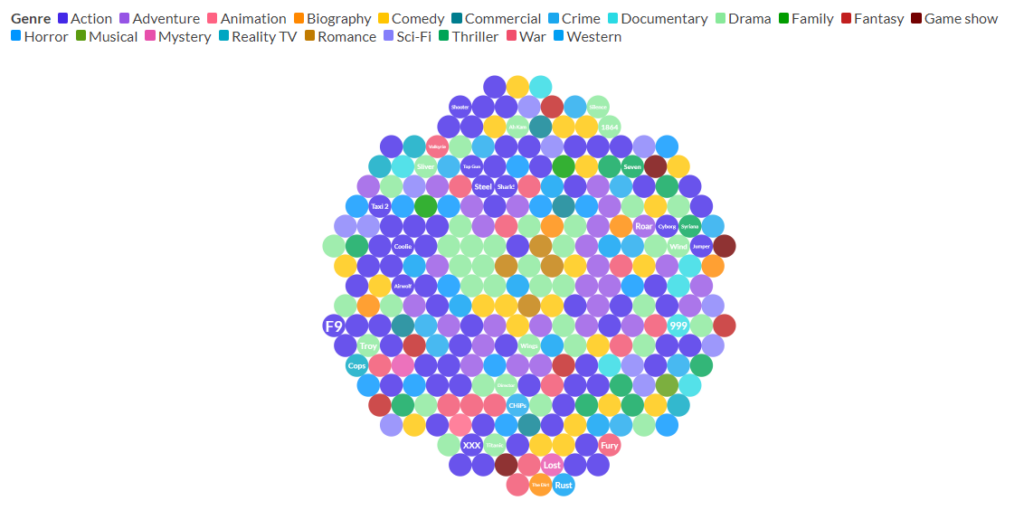
This is a more purposeful way of presenting the data:
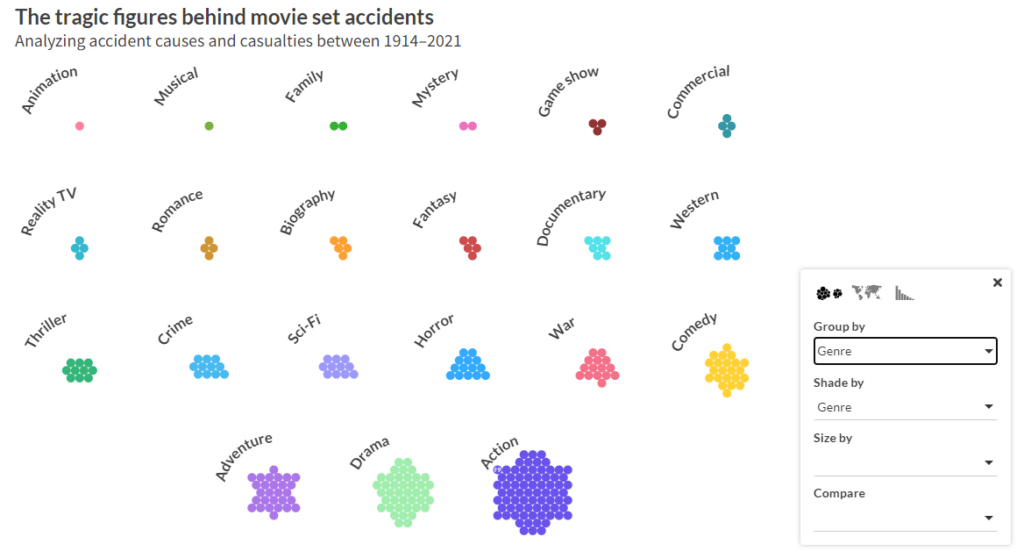
This is a geographical way of presenting the same data (what’s up with Hawai? Remind me never to shoot a movie there!):
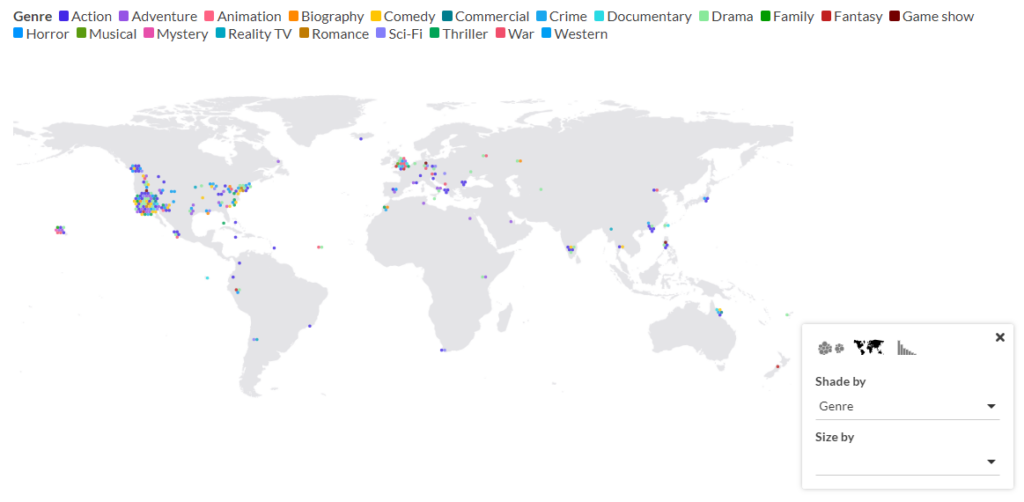
This one gives a clear view of the victims (stunt performers aren’t the ones getting in the most accidents!):
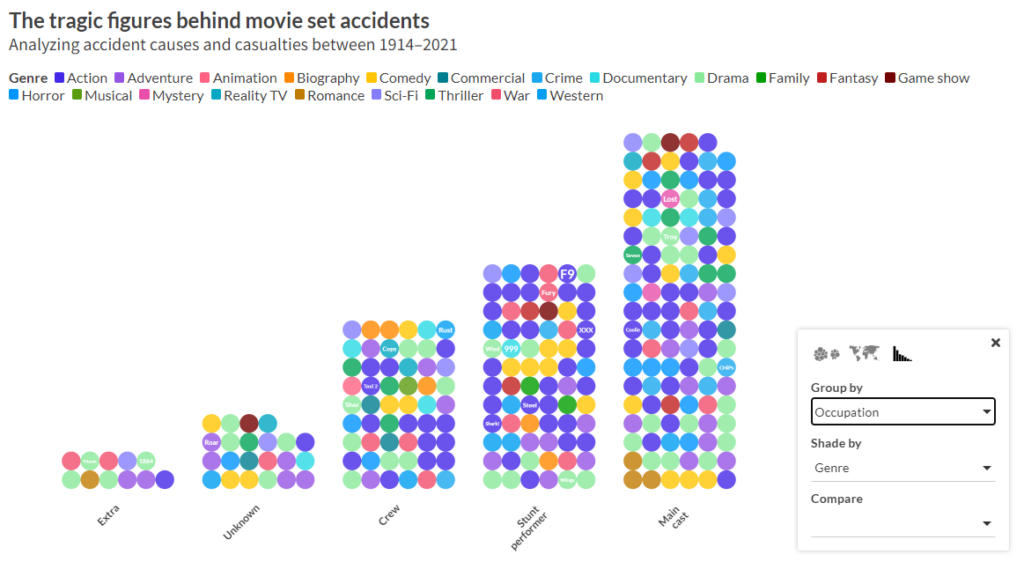
I could go on and on.
How well it offers the key benefits (and why):
- Does it save you time and energy? Just like with the network visualization tool, Kumu, I’d say this is fantastic software for consulting firms or research agencies that constantly gather and present a lot of data. For smaller firms, I feel there may be more time invested than saved, although Flourish does offer a lot of great templates.
- Does it improve your output? Oh yes. The visuals speak for themselves. And what’s more, you can repurpose them in many ways: Embed them on your website, even create Canva-friendly versions, and update visuals in real-time based, on live data.
- Does it increase the expertise of your firm? As a copywriter, I consider storytelling to be a very important skill for anyone to have. Using a tool and the templates of Flourish develops a consultant’s instinct to present data-driven insights in more compelling ways. So, I’ll hand out a slightly biased star for this one.
Other data storytelling tools to check out:
- Infogram: A web-based tool for creating infographics, charts, and maps. It’s user-friendly and ideal for consultants who need to create visually appealing reports and presentations quickly.
- Datylon: A particularly useful tool for your consultant toolkit, if you need to create sophisticated and visually appealing reports and infographics. It integrates with tools like Adobe Illustrator and Microsoft Powerpoint.
5. Network analysis tool: Kumu ⭐⭐
The problem(s) it solves:
In the world of services, human relationships are pivotal. But their dynamics are not always that easy to fathom: Consultants who lead large and collaborative projects with various affected stakeholders sometimes struggle to understand the network: How do these stakeholders interact and influence each other? What are the knowledge gaps between them? How can their plans and plannings be aligned?
Consulting agencies are always looking for effective ways to build their own influence in large organizations or networks of different organizations to become trusted advisors.
Social services organizations often use strengths assessments and needs assessments to gather data about communities. Depending on the scale and the diversity of these communities, it can be difficult to visualize assets and weaknesses geographically.
How it solves the problem:
Kumu aids its users in organizing complex data into relationship maps. By doing so, it becomes easier for them to spot key influencers and track networks. Kumu’s website offers a gallery of examples of how their tool is used.
One example, shown below is a visual network analysis of higher education grantmaking in Detroit, Michigan (USA) in 2016. It represents 152 grants, corresponding to nearly $22 million in funding, all summarized in a single interactive visual.
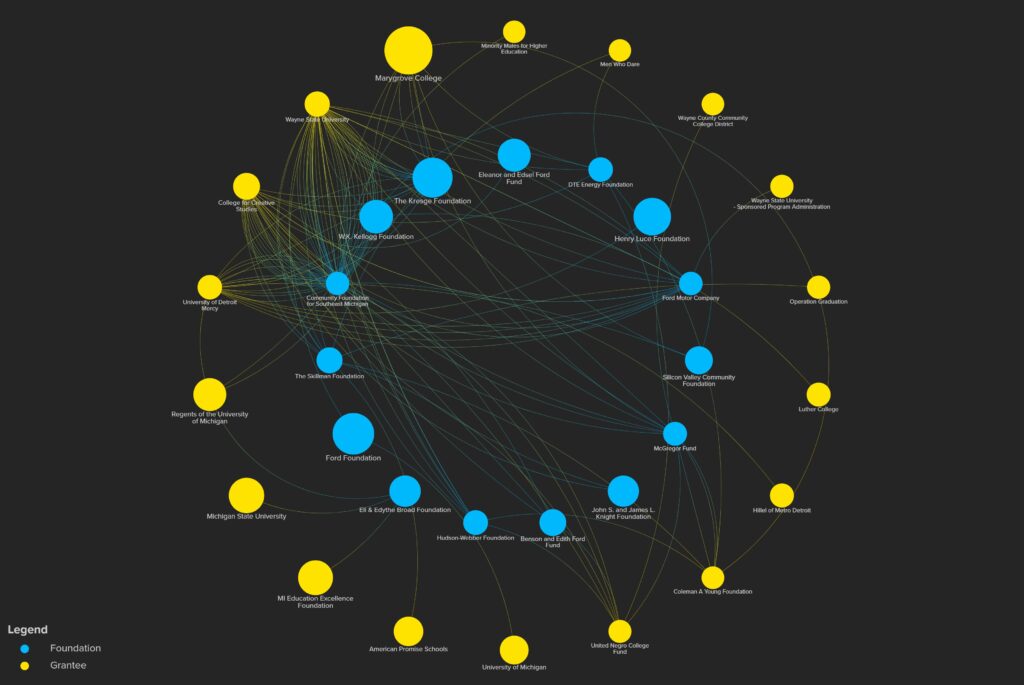
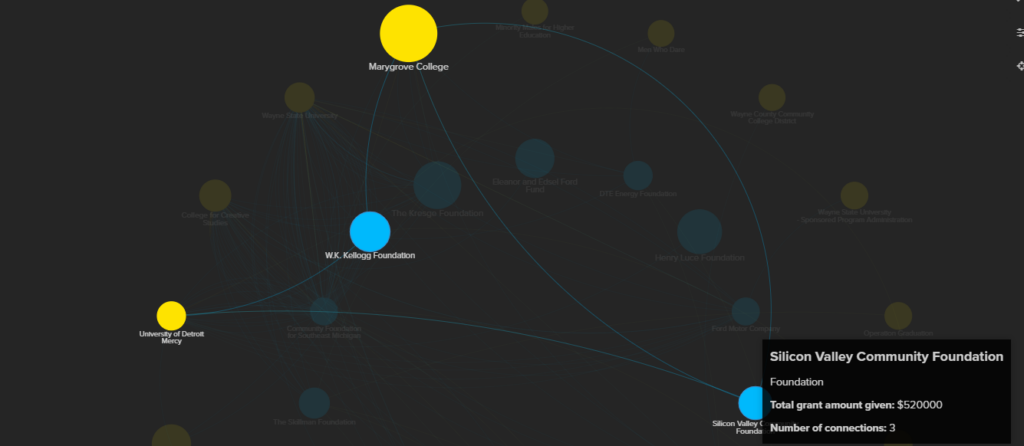
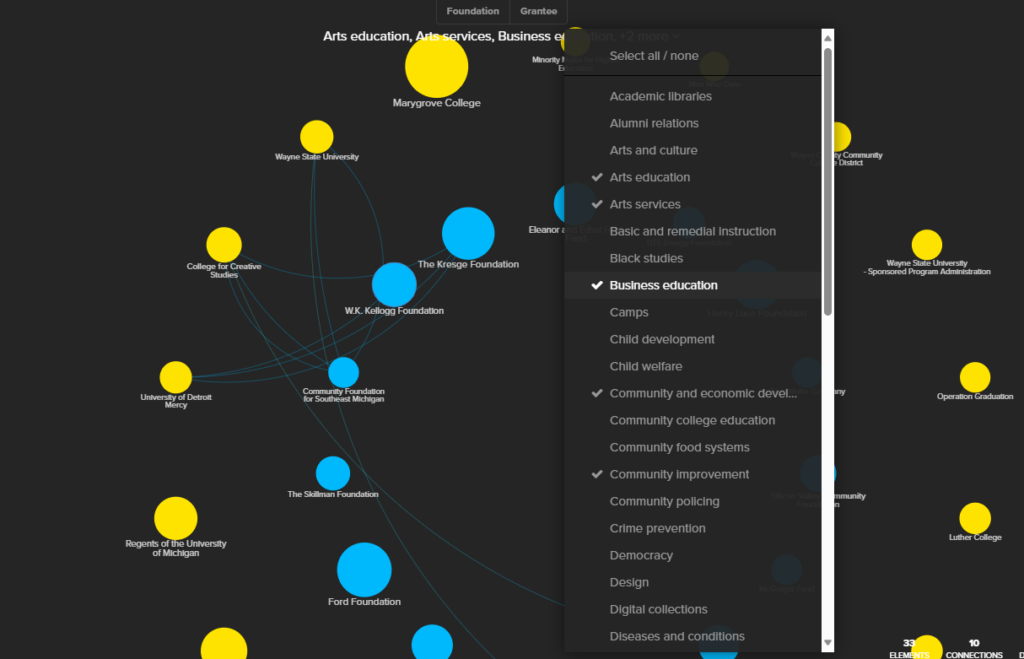
How well it offers the key benefits (and why):
- Does it save you time and energy? Not tremendously. By design, I don’t believe this is one of the key aims of the tool. Rather, it is meant for those who want to go the extra mile to understand their stakeholder audience more deeply. Time gain could be found in the fact that these Kumu-built visuals facilitate discussions about complex data, but I can only assume a great amount of energy goes into setting them up.
- Does it improve your output? That’s exactly what it does. Data is very valuable, but it’s worthless if it can’t be interpreted. A tool like Kumu brings the visual structure that’s necessary.
- Does it increase the expertise of your firm? Yes. Initially, I wasn’t going to hand out a star for this one, because Kumu isn’t technically a tool that collects knowledge or teaches consultants new skills in any straightforward way. However, understanding your own network and the recurring dynamics within, does improve your intrinsic understanding of how to nurture your consultancy business.
Other network analysis tool to check out:
- Cytoscape: Originally designed for biological research, Cytoscape is now used widely for various types of network analysis. It’s highly customizable and can handle complex network data
6. Scenario planning software: Futures Platform ⭐⭐⭐
The problem(s) it solves:
You may have demanding customers who say: “Enough with the storytelling. Just tell me what storylines I should expect to unfold, and help me plan for it!”
Your strategic foresight and advice as a consultant are anchored in your experience and know-how, your ability to conduct risk assessments or maturity assessments, and the data you retrieve. However, getting your customers to plan the right actions and giving them structured guidance can be quite challenging.
How it solves the problem:
Futures Platform offers a very complete suite. One that provides limitless resources to keep your finger on the pulse of future trends and disruptions, and that provides a scenario-building tool. The latter allows you to work together with dedicated subject-matter experts – within your customer’s organization for instance – to plan and prepare for different scenarios.

The Futures Platform proves to be invaluable software for consulting businesses and their customers. For instance, systematic scenario simulation and analysis help identify the unmet needs of consumers and the future impacts of technologies, regulations, or societal evolutions.
How well it offers the key benefits (and why):
- Does it save you time and energy? Yes. This consulting tool centralizes quality resources and research that would otherwise require a lot of time to gather. With Futures Platform you dispose of a foresight radar to pick up on signals and trends that are important to your customers.
- Does it improve your output? Ditto. The tool gets you to ground the strategic advice in a comprehensive understanding of (future) trends while letting you take into account different possible scenarios. That results in more visionary and robust recommendations.
- Does it increase the expertise of your firm? Third star granted! With a tool like this at the disposal of consultants in your firm, staying in touch with markets, industries and, society becomes second nature.
Other scenario planning tools to check out:
- Anaplan: Known for its business planning and performance management features, Anaplan also offers scenario planning functionalities suitable for various business contexts.
- SAP Analytics Cloud: Offers advanced analytics capabilities including predictive analysis and scenario planning, making it a good choice for consultants working with large enterprises.
How to choose the right consulting software
If you stumble upon an innovative consulting tool and in your estimation, for your situation, it doesn’t score more than one key benefit star, I’d advise against adopting it. It’s always worth keeping an eye on further developments, but it simply wouldn’t make any sense to make an investment yet.
For the consulting tools that do seem to brighten up your sky with more than one star, if you have to choose between one software or another, evaluate them based on the following criteria:
1. Feature set and capabilities
Check for unique functionalities that set one tool apart from competitors. Investigate how likely it is that competitors soon catch up and offer the same. Depending on how many real problems you’re trying to solve at once, consider which tool offers the most features and capabilities needed for your consulting practice.
2. User-friendliness
Evaluate the tool’s user interface and overall user experience. You want to minimize the learning curve and increase adoption rates among team members (and maybe customers). However, don’t confuse user-friendliness with a mere lack of capabilities. Complex problems may require a learning curve to solve, even with a digital tool.
3. Integration and compatibility
Determine how well the tool integrates with other software and systems you are currently using. Compatibility with existing ecosystems is crucial for seamless workflows and data synchronization.
4. Scalability
Consider whether the tool can scale according to your business needs and adapt to different project sizes and complexities. A good tool should grow with your business and be flexible enough to accommodate various types of consulting assignments.
5. Support
The more tools are being launched, the more rare high-quality and personalized support is becoming. Look into the level of customer support provided, including training resources, customer service responsiveness, and the frequency of updates and bug fixes. Reliable and prompt support is essential for minimizing downtime and ensuring smooth operations.
Innovative but also essential: Why assessment software should be part of your consultant toolkit
I started by laying out a few essential tools for consulting firms. I can think of almost no reason for any firm not to have these in place. The list of consulting software that followed will hopefully help you discover ways of creating a competitive advantage over your competitors.
Maybe you wonder why I didn’t place our very own Pointerpro software in either of these lists. The reason is twofold:
- Pointerpro belongs in both categories: essential and innovative
- This way I get to end my article with a short pitch for our tool.
Why is Pointerpro both an essential and innovative element in any consultant toolkit?
Collecting and analyzing their own data effectively is fundamental for consultants because it allows them to develop their own expertise, as opposed to relying on collective knowledge – something we tend to do more and more since the emergence of AI tools for consultants. Pointerpro allows you to build highly interactive and engaging questionnaires that ensure high response rates.
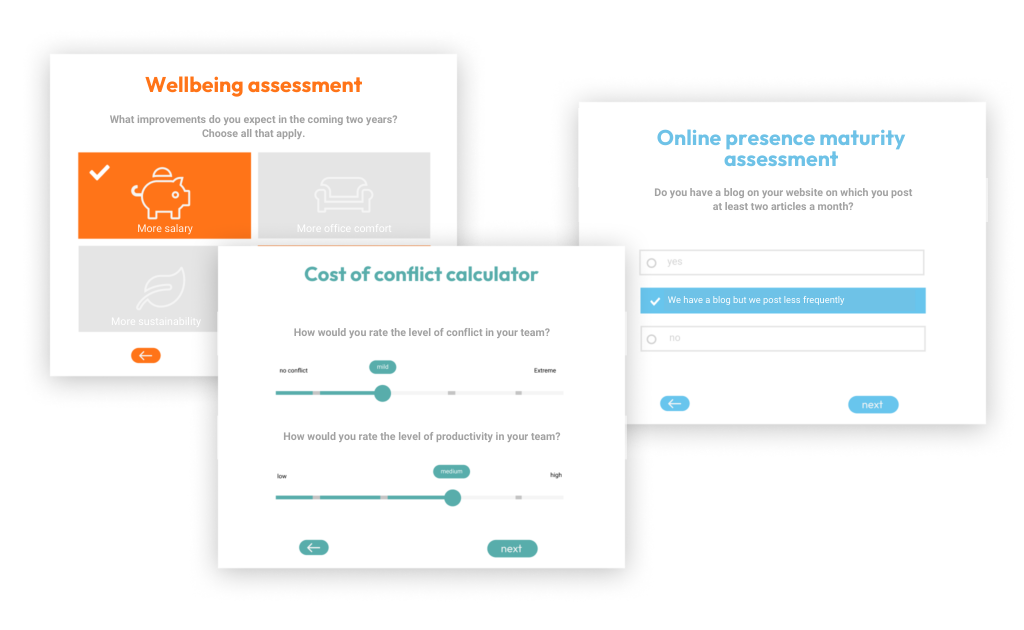
One of the key ways Pointerpro helps you to innovate your consulting business is by allowing you to “democratize” your professional advice – to the extent that’s beneficial to you. Allow me to explain:
Next to its Questionnaire Builder, Pointerpro offers a Report Builder. And because they’re connected, you digitalize and automate your advice delivery. When respondents fill out your questionnaires, Pointerpro auto-generates personalized PDF reports, for them (and/or for other stakeholders based on group results).
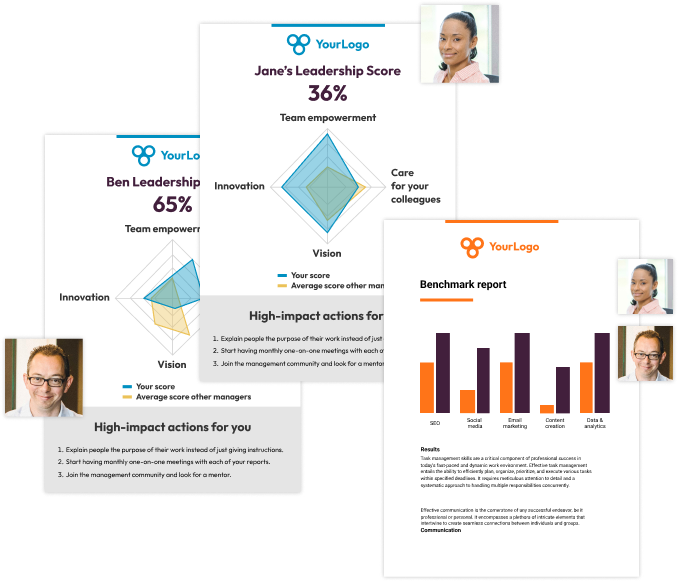
The result? You get to serve a much broader audience, much more efficiently. There are numerous ways for you to position your digital assessments and advice reports.
- You can create sample assessments to trigger customers and generate online leads.
- You can sell full-blown assessments as digital products.
- You can monetize even further by letting your network distribute or re-sell your assessments.
Do you want to explore the ways you can grow your business without having to increase your payroll, using Pointerpro? Browse away on our website for more inspiration and get in touch with our team.


